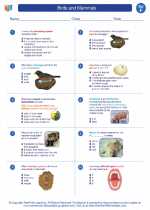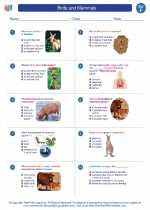Grasslands
Grasslands are ecosystems dominated by grasses, with few trees or shrubs. They are found on every continent except Antarctica and are sometimes referred to as prairies, steppes, or savannas, depending on their location and climate. Grasslands can be found in both temperate and tropical regions, and they play a crucial role in the global ecosystem.
Types of Grasslands
There are two main types of grasslands: tropical and temperate.
- Tropical Grasslands (Savannas): Located near the equator, these grasslands have warm temperatures year-round and distinct wet and dry seasons. Savannas are home to a diverse array of wildlife, including large herbivores like elephants and giraffes.
- Temperate Grasslands (Prairies and Steppes): Found in regions with harsh winters and hot summers, temperate grasslands are characterized by their deep, fertile soils. They are home to grazing animals such as bison and pronghorn antelope.
Key Features of Grasslands
Grasslands are known for their unique characteristics, including:
- Grasses as Dominant Vegetation: Grasses are the primary plants in these ecosystems, and they have adapted to survive in dry, open environments.
- Fire Adaptation: Many grassland species are adapted to fire, which helps maintain the open nature of the landscape and promotes new growth.
- Biodiversity: Despite their seemingly uniform appearance, grasslands support a rich diversity of plant and animal species, many of which are specially adapted to the grassland environment.
- Human Impacts: Grasslands have been heavily impacted by human activities, including agriculture, urban development, and grazing. Conservation efforts are crucial to protect these important ecosystems.
Study Guide
Here are some key points to remember when studying grasslands:
- What are the main types of grasslands, and what are their defining characteristics?
- How have grassland ecosystems adapted to factors such as fire and grazing?
- What are some of the key plant and animal species found in grasslands, and how are they specially adapted to this environment?
- What are the main human impacts on grasslands, and what conservation measures can be implemented to protect these ecosystems?
Remember to study the unique features and ecological significance of grasslands, as well as the human factors that threaten their preservation. Understanding the role of grasslands in the global ecosystem is crucial for appreciating their importance and advocating for their conservation.
[Grasslands] Related Worksheets and Study Guides:
.◂Science Worksheets and Study Guides Sixth Grade. Birds and Mammals

 Activity Lesson
Activity Lesson
 Worksheet/Answer key
Worksheet/Answer key
 Worksheet/Answer key
Worksheet/Answer key
 Worksheet/Answer key
Worksheet/Answer key
 Worksheet/Answer key
Worksheet/Answer key
 Vocabulary/Answer key
Vocabulary/Answer key
 Vocabulary/Answer key
Vocabulary/Answer key
 Vocabulary/Answer key
Vocabulary/Answer key
 Vocabulary/Answer key
Vocabulary/Answer key
 Vocabulary/Answer key
Vocabulary/Answer key
